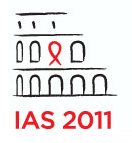Dolutegravir: 48 week results from phase II study in treatment-naive patients
1 August 2011. Related: Conference reports, Antiretrovirals, IAS 6th Rome 2011.
 Simon Collins, HIV i-Base
Simon Collins, HIV i-Base
Dolutegravir is an integrase inhibitor in development with ViiV/Shionogi that in earlier development was referred to as GSK-572. Results from the first monotherapy studies were presented only two years ago and the rapid development programme now includes phase III studies in naive patients (using a 50 mg once-daily dose) with results already reported from phase II studies in experienced patients (using a higher 50 mg twice-daily dose).
Results from week 24 of a Phase IIb dose-ranging study treatment naive study were presented in Glasgow last year with 90-96% of patients in the dolutegravir arms reducing viral load to <50 copies/mL compared to 78% patients in the efavirenz arm. These were updated to week 48 at in an oral presentation in Rome. The initial steep viral decline seen with integrase inhibitors as a class was probably a factor in choosing a primary endpoint at week 16 but this extended data is more crucial to understand sustainability. [1]
The study randomised 205 treatment-naive patients 1:1:1:1 to 10 mg, 25 mg or 50 mg of dolutegravir or efavirenz 600mg once-daily, plus either investigator choice of either tenofovir/FTC (used by two-thirds of patients) or abacavir/3TC.
Baseline viral load was originally low (approximately 30,000 copies/mL) with only 26% participants >100,000 copies/mL. This would increase effectiveness for the a viral suppression (requiring less than a 3 log drop to achieve undetectable levels. Participants were largely male (86%) and white (80%), with mean CD4 count of 324 cells/mm3 (63% were <350). Median age was 32 (range 20-79 years).
By week 48, suppression in the dolutegravir arms had dropped slightly to 88-91% compared to 82% in the efavirenz arms. No between group analyses were presented but the confidence intervals for all groups broadly overlapped. Virologic non-response/rebound rates were low and similar between arms (8%, 6%, 4% vs 6% in the efavirenz arm) with the lower response in the efavirenz arm driven by discontinuations related to side effects (0, 2%, 0 vs 8% respectively). In the small percentage of patients failing with viral rebound 0/3 (none in the 50 mg arm) showed evidence of integrase-related mutations, though patients were proactively switched early due to this potential concern.
Virological results were also presented using a <2 copies/mL viral load test the first time perhaps for an ongoing Phase II study. At the 50 mg dose approximate suppression to <2 copies at weeks 16, 24 and 48 was 48% 65% and 52% respectively compared to 35%, 45% and 58% in the efavirenz arm. These are small study numbers and neither confidence intervals nor statistical comparisons were provided but these are unlikely to show significant differences. It may be notable that the <2 copies/mL results for the lower doses of dolutegravir were not presented. Given the increased research focus on greater suppression at levels below < 50 copies/mL and the conflicting results from some of the intensification studies with raltegravir (broadly finding no impact in blood but perhaps in some tissue sites) this class potential is likely to inform future studies.
CD4 increases were similar by week 48 with +231 cells/mm3 in the combined dolutegravir vs +174 in the efavirenz arm vs EFV (p=0.076), reducing a difference that was significantly higher at week 24.
No new serious adverse events were reported out to week 48. The two discontinuations from the dolutegravir arms were due to dyspepsia (25 mg arm) and Burkitts lymphoma.
Grade 2-4 side effects were similar between arms, except for rash and CNS-related side effects occurring only in the efavirenz group. Nausea (11%), diarrhoea (8%) and headache (5%) were most frequently reported with dolutegravir compared to dizziness (18%), fatigue, insomnia and rash (8% each) with efavirenz. Grade 3/4 laboratory abnormalities occurred in 12% vs 14% of the combined dolutegravir vs efavirenz arm. Dolutegravir was associated with mean increases in creatinine (6.4-11.9 mmol/L) at week 1 that were stable to week 20 and decreased by week 48. In vitro data have shown that dolutegravir causes a benign inhibition of creatinine secretion. These were detailed in a separate poster presentation. [2]
Lipid changes were generally greater in the efavirenz arm but there were no differences either from baseline or between drugs in the TC/HDL ratio at week 48 (due to the impact of efavirenz in increasing HDL).
The pharmacokinetic summary slide showed an impact of dose on drug levels over 24 hours, but these had low inter-patient variability and at all doses remained above the IC90 (0.064 ug/mL) with Cmin levels [geometric mean (CV%)] of 0.30 (71), 0.54 (67) and 1.20 (62) and an inhibitory quotient of 4.7, 8.4 and 19-fold for the 10 mg, 25 mg and 50 mg doses respectively.
References
- Van Lunzen J et al. Rapid, robust and sustained antiviral response with once-daily (QD) dolutegravir (DTG, S/GSK1349572), a next generation integrase inhibitor (INI) in combination therapy in antiretroviral-naive adults: 48 week results from SPRING-1 (ING112276). 6th IAS Conference on HIV Pathogenesis, Treatment and Prevention, 17-20 July 2011, Rome. Oral abstract TUAB0102. Webcast.
- Min S et al. Safety profile of dolutegravir (DTG, S/GSK1349572), a next generation integrase inhibitor (INI) in combination therapy in antiretroviral (ART)-naive and ART-experienced adults from phase 2b studies. 6th IAS Conference on HIV Pathogenesis, Treatment and Prevention, 17-20 July 2011, Rome. Abstract TUPE238.

